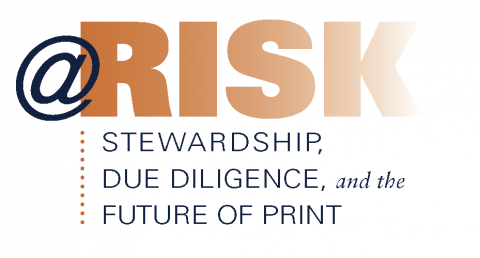Last week we submitted for member vote a resolution to authorize CRL serial titles digitized to preservation standards to be transferred and merged, under certain specified conditions, with the holdings of other trusted repositories. In framing the resolution we drew upon the lessons of CRL’s 67-year history of shared print, and the conversation about stewardship and due diligence at the recent @Risk Forum. The resolution prompted interest at some member libraries in details of the proposed arrangement with the Linda Hall Library. Although the resolution carried unanimously we thought it would be appropriate to provide those details here:
-
The resolution itself is broader in scope than the current relationship with Linda Hall.
-
We want to establish ground rules for handling other appropriate collections in this way. Although we don’t have any others in mind, cooperative digitization arrangements are likely to become more important as CRL collections become more fragile and difficult to replace. Like all decisions on disposition of CRL collections, such arrangements will continue to be subject to oversight by the Board and Collections and Services Policy Committee (CSPC). In essence, we are seeking authorization for Board and CSPC approval of such decisions in the future.
-
What "acceptable preservation standard" will CRL apply when considering such digitization and transfer projects?
-
Standards will depend upon the nature of the materials digitized. For the Linda Hall materials, which are mainly printed text and line art or photo-offset images, we considered the following specifications appropriate: for archive scans, single-page TIFF files, 300 dpi, 24-bit color; for production files JPEG 2000 page images and searchable PDFs.
-
What is the preservation strategy for CRL digitized holdings?
-
To preserve its digital assets CRL employs both offline (hard drive) and online (spinning disk) redundant storage, and monitoring. Master scans (TIFF files) are stored at Amazon Web Service S3 storage and held locally on a CRL-hosted processing server with daily incremental and weekly full backups. Production files (PDF files) are stored on an EMC unified storage platform, a network-attached storage (NAS) system hosted by CRL, with daily and weekly disk backup for fast on-site restoration, and monthly tape backup in an off-site safe deposit for major disaster recovery.
It is important to note that these assets are all derivative files, i.e., they were produced from paper and microform originals that continue to be preserved by CRL and/or trusted partners for rescanning should that become necessary. Therefore the digital files are not the ultimate fallback for CRL in maintaining and delivering collections to members.
-
Will CRL consider how many complete runs of a title are preserved in the US before issues are actually disposed of? If so, what is the absolute minimum number we need to have before we are comfortable disposing of volumes?
-
If and when we decide to discard duplicate volumes, we will consider how many complete runs of the title exist, and where and how those runs are maintained. We have not yet determined what the minimum number would be. Normally CRL holdings are not widely held and therefore there are likely to be few backup repositories. Even the backup repositories that exist, however, are unaudited, and we have found that holdings data in OCLC is not a reliable indication that holdings described are actually on shelves. For this reason CRL formed its partnership with Linda Hall, to provide secure, specialized stewardship and curation of holdings. However, the better part of caution is to retain the print duplicates for the time being. Space is not an issue -- or a motivating factor.
-
Is keeping track of the volumes to which CRL has rights adequate to ensure retention?
-
The Linda Hall Library provides other important safeguards that give the Board and CSPC confidence. The right of first refusal granted CRL in its cooperative agreement with LHL formalizes our claim to the volumes in question in the unliely event that LHL were to decide to disperse its assets. In such an event LHL collections, being extremely valuable, would likely be placed with a worthy successor organization, perhaps a CRL library with a similar collecting focus. CRL will also take possession of high-quality digital files of all issues of the journals. Another factor we took into account was the LHL financial assets ($233 million as of 2014) dedicated by terms of its founding trust to maintaining and developing the LHL collections. We think these factors, together, go a long way to ensure retention.
-
Could CRL actually accommodate a return of such materials, given the current constraints on space?
-
Yes, CRL can accommodate the return of the items. Space is not an issue.
-
We don't yet have a common understanding of what we should expect from a print repository. Should we wait to learn from HathiTust and other shared print initiatives?
-
CRL has functioned as a shared print repository for a long time: the five million volumes we hold consist of items either transferred to CRL from member libraries or acquired on behalf of the community over the course of 67 years. This experience has given us a common understanding of what we should require of a print repository, and this understanding of the dynamics and economics of print sharing informs our partnership with Linda Hall. We are in fact watching activities at HathiTrust, and carefully coordinate with them our priorities for print digitization and collection development. We consider this an imperative, since a significant number of CRL members support HT.
Bernard F. Reilly
President (2001-2019)
Center for Research Libraries
